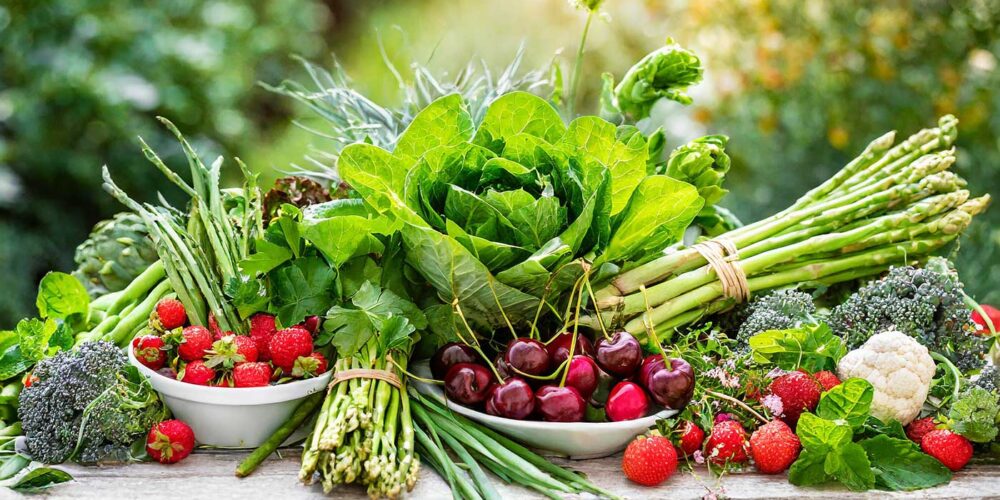
Health traditions like Ayurveda and Traditional Chinese Medicine (TCM) view the body and mind as primed to receive nourishment in rhythm with nature’s cycles. Both philosophies believe in the benefits of eating seasonal foods to align with these natural changes. This way of eating is quite intuitive. For instance, when the weather is warm and dry, juicy foods, like watermelon and cucumbers, might sound more refreshing than root vegetables. Warming roasted beets might hit the spot in the cooler days of fall and winter, and by spring, you might be craving naturally cleansing vegetables, like crispy, spicy radishes and asparagus.
Following this intuition and eating a primarily seasonal and local diet can help you create a healthy internal environment, or balance, in the body. Not only will you meet your body’s seasonal needs, you will also support your gut microbiome, your immune system, and the environment. In addition to complementing your body’s cyclical rhythm, there are other reasons that eating as seasonally and close to the source as possible may benefit your health and the environment.
Springtime marks the transition from the dormancy of winter to the renewal of life. Energy is bubbling to the surface of the earth, and green plants sprout, shoot, and grow. Your body may crave foods that support the body’s natural detoxification and digestive processes during spring. Consider honoring your spring cravings by eating naturally-cleansing, in-season foods.
Spring brings a bounty of fresh and vibrant foods that signal the end of winter and the beginning of warmer weather. Embracing seasonal eating during spring can offer numerous benefits for your health and well-being. Here are the many benefits of seasonal eating:
Supports a Diverse Gut Microbiome: The type of food that grows changes with each season, so as you shift your food intake, you feed a variety of beneficial bacteria that live inside your system. This in turn creates stronger immunity and better overall health.
Nutrient Density: Fruits and vegetables begin to lose some key nutrients within 24 hours of being picked. The majority of the food consumed today is picked unripe before being shipped thousands of miles. When it arrives, it’s both less flavorful and less vital. One of the best ways to eat seasonally is to eat local foods. Choosing locally grown foods that are ripened on the plant for as long as possible means your ingredients will have the greatest possible number of nutrients. Studies show that even after being picked, fruits and vegetables are still living, metabolizing structures able to maintain circadian clocks and cellular functions. These internal clocks continue to regulate aspects of metabolism, including respiration, even as you put that spoonful of blueberries to your mouth. The less distance your food travels from the field to your plate, the more you ingest living plant cells and the higher the nutritional value these cells contain.
Reduced Chemical Exposure: Seasonal, local produce usually has fewer chemicals. Fruits that are harvested ripe have a shorter shelf life, many suppliers shipping food great distances pick fruits before they ripen, then use chemicals, such as ethylene, to artificially ripen them to stay looking fresh longer. Fruits can also be injected to look more colorful or coated in unhealthy waxes to keep them fresh. Locally produced fruits and vegetables, on the other hand, are usually free of the added chemicals that keep produce “fresh” during transportation and beyond.
Environmental and Community Support: Food travels an average of 1,500 miles before it ends up on your plate! This can make it difficult to trust what’s in your food, how it’s been handled and how the workers growing your produce have been treated and compensated. By choosing seasonal, local food, you’ll know where your food comes from. In addition, your food choices can reduce the carbon footprint that mass food production and distribution leave on the planet and will financially support individuals and families in your community rather than large food corporations.
Eating with the cycles of nature creates the opportunity to tune in to and celebrate the seasons. In doing so, you become inspired to create meals featuring the delicious flavors each season has to offer. Each season offers an abundance of foods that are naturally supportive and align with the conditions of the season.
In spring, embracing fresh, vibrant produce can invigorate your meals and support your body’s natural detoxification and renewal processes. Consider honoring your spring cravings by eating naturally cleansing in-season foods. Here are some favorites:
- arugula
- asparagus
- berries
- broccoli
- cabbage
- cherries
- dandelion greens
- endive
- fiddleheads
- leeks
- nettles (cook well)
- peas
- radishes
- rhubarb
- spinach
- sprouts

Leave a Reply